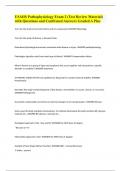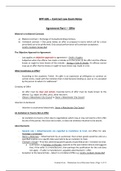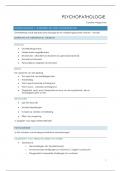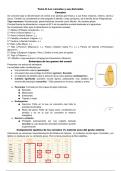Microbiology and Microbiological Techniques
In order to classify Organisms, we have three domains and five kingdoms.
The domains are Archaea, Bacteria and Eukarya.
The kingdoms are Bacteria, Protista, Fungi, Plantae and Animalia.
4 kingdoms come under Domain Eukarya which involves Plantae, Fungai, Animalia and Protista.
Under the Bacteria Domain there are only bacteria and under the Archaea Domain there is only
Archaea.
Microorganisms are very different. They include bacteria, fungi, algae, and protozoa, plants,
and animals. Unicell microorganisms were the first forms of life to develop on earth,
approximately 3 billion - 4 billion years ago. Microorganisms tend to have a relatively rapid
evolution. Most microorganisms can reproduce rapidly, and microbes such as bacteria can also
freely exchange genes through transformation and even between different species.
The Gram stain characterizes bacteria based on the structural characteristics of their cell walls.
By Gram-staining, most bacteria can be classified as belonging to one of 4 groups Gram-positive
cocci, Gram-positive bacilli, Gram-negative cocci, and Gram-negative bacilli. The Gram stain,
developed in 1884 by Hans Christian Gram, characterizes bacteria based on the structural
characteristics of their cell walls. The thick layers of peptidoglycan in the Gram-positive cell wall
stain purple, while the thin Gram-negative cell wall appears pink.
We can also use Phenotypic Methods to Classify and Identify Microorganisms such as naming
and grouping organisms based on similarities. Microorganisms can be classified based on cell
structure, cellular metabolism, or on differences in cell components such as DNA, fatty acids,
pigments and antigens and etc.
Bacteria lack membrane bound organelles and can function and reproduce as individual cells,
but often aggregate in multicellular colonies. Bacteria Genome is usually a single loop of DNA
called plasmids. These plasmids can be transferred between cells through bacterial conjugation.
Bacteria is surrounded by a cell wall, which protects cell and gives rigidity to their cells.
Archaea In the past, the differences between bacteria and archaea were not recognized and
archaea were classified as bacteria as part of the kingdom Monera. Archaea are also single-
celled organisms that lack nuclei. Archaea in fact differ from bacteria in their genetics. While
bacterial cell membranes are made from phosphoglycrides with ester bonds, Archaean
membranes are made of ether lipids.
Eukaryotes Unlike bacteria and archaea, eukaryotes contain organelles such as the cell nucleus,
the Golgi apparatus, and mitochondria in their cells, like bacteria, plant cells have cell walls and
contain organelles such as chloroplasts, vacuole in addition to the organelles in other
eukaryotes.
, In classification of Prokaryotic organisms were the first living things on earth and still inhabit
every environment, no matter how extreme.
In the past, scientists grouped living things into five kingdoms animals, plants, fungi, protists,
and prokaryotes based on several criteria such as the absence or presence of a nucleus and
other membrane bound organelles, the absence or presence of cell walls, multicellularity and
etc.
Gram staining results are most used as a classification, In the late 20 th century, Carl Woese and
other scientists compared sequences of small subunit ribosomal RNA which resulted in a more
fundamental way to group organisms on earth. Based on differences in the structure of cell
membranes and in ribosomes, Woese and other scientists suggested that all life on earth
evolved along three sections, called domains. The domain Bacteria comprises all organisms in
the kingdom Bacteria, the domain Archaea comprises the rest of the prokaryotes, and the
domain Eukaryotes, including organisms in the kingdoms Animalia, Plantae, Fungi, and Protista.
Two of the three domains, Bacteria and Archaea, are prokaryotic. Based on fossil evidence,
prokaryotes were the first on Earth, appearing 3.5 to 3.8 billion years ago. These organisms are
present everywhere.
Bacterial species differ amongst each other based on several characteristics, which highlight
their identification and classification. Some of Diagnostic methods include Microbial culture,
microscopy and biochemical tests.
Culture allows identification of infectious organisms by examining their microscopic features, by
detecting the presence of substances produced by pathogens, and by directly identifying an
organism by its genotype. Microbiological culture is a principal tool used to see infectious
diseases. In a microbial culture, a growth medium is provided for a specific agent. A sample
taken from potentially diseased tissue or fluid is then tested for the presence of an infectious
agent able to grow within that medium. Microscopy may be carried out with simple apparatus,
such as the compound light microscope, or with apparatus as complex as an electron
microscope. Samples obtained from patients may be viewed directly under the light microscope
and can often rapidly lead to identification.
Eukaryotic cells are larger and more complex than prokaryotic cells. The DNA of aeukaryotic cell
is neatly packaged within its nucleus, and there are several different structures. The structures
located in eukaryotic cells may include the endoplasmic reticulum, golgi apparatus,
mitochondria, and ribosomes, as well as chloroplasts in photosynthetic cells. Examples of
eukaryotic microorganisms include fungi, algae, protozoa and various microscopic parasitic
worms.
00:0000:00
Bacteria are known as Prokaryotes, made up of one cell. All bacteria are a couple of
micrometers in length. Bacteria have features such as ribosomes which make proteins from











